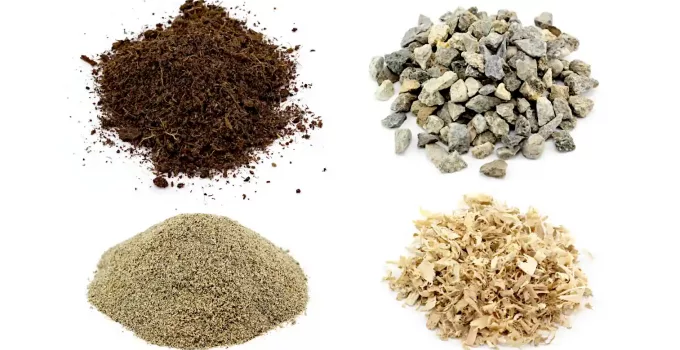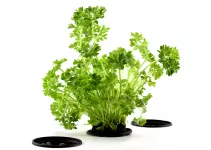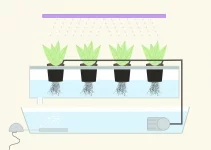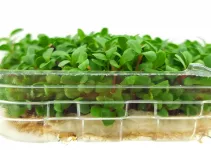Searching for the best hydroponic growing medium is of vital importance because you can’t actually grow plants in a hydroponics system if you don’t have a growing medium.
Aeroponics is pretty much the exception to the rule. Even aquaponic systems need growing media.
The growing media is the component in a hydroponics system that replaces the soil.
The problem is that, since there are so many options to choose from, things can get overwhelming. Which brings me to writing this post on the best hydroponic growing medium.
However, if you’re a complete beginner and you don’t want to build your own system, I recommend checking out my reviews for hydroponic kits for beginners. Those hydroponic indoor gardens (AeroGarden, iDoo) are easy to use, you just have to buy grow sponges for future crops. There’s no need to worry about which is the best hydroponic grow medium.
Table of Contents
Best Hydroponic Growing Medium: Top Picks
1. Rockwool: NREOY 1.5 inch Rockwool/Stonewool Grow Cubes
Rockwool can be used in pretty much all hydroponic systems. It’s the top choice when we’re looking for the best hydroponic growing medium. But it’s also the preferred choice for germinating seeds. The major con against rockwool is that it’s a non-degradable material, non-compostable. If those are real impediments for you, then you’ll prefer coco coir instead of rockwool.
2. Hydroton: Mother Earth Hydroton Original Expanded Clay Pebbles
Most of the times, we use a combination of rockwool and hydroton or expanded clay aggregate. We germinate the seeds in rockwool cubes and then we fill in the space in our net pots with hydroton. This combination is a winning hydroponic growing medium for most of us.
3. Coconut fibers: Coco Bliss – Premium Coconut Coir Pith
Coco coir is the organic alternative to peat moss. It’s also the perfect replacement for those who don’t want to use rockwool under any circumstances. Coco coir is becoming a favorite hydroponic growing medium for a lot of growers. It’s a top recommendation for the best hydroponic growing medium.
Best Hydroponic Growing Medium: 17 Popular Options
Right from the beginning, let me offer you a little intel about what I’m going to be talking about in this article:
- rockwool
- expanded clay aggregate (hydroton)
- coconut fibers (coco coir)
- perlite
- growstones
- vermiculite
- rice husks
- oasis cubes
- pumice
- jute substrate
- hemp substrate
- neoprene plug substrate
- peat moss
- pea gravel
- sand
- wood chips
- compost bark
How to Choose the Best Hydroponic Growing Medium
Those brief examples of hydroponics growing media enumerated above are more than enough to get you started.
There is no absolute best hydroponic growing medium, there’s a bunch that work for each type of system.
1. DWC (deep water culture)
Preferably a medium that holds oxygen and that anchors the plants.
Hydroton, also known as expanded clay aggregate, is the best hydroponic growing medium for DWC.
Some users have also tried out pea gravel with success, while others germinate seeds in rockwool and transfer the seedlings together with the rockwool cubes in net pots that also contain expanded clay aggregate.
2. Wick system
It requires a medium that absorbs plenty of water and nutrients and holds on to them for longer periods of time: coconut fiber, pro-mix, vermiculite, perlite.
3. NFT (nutrient film technique)
Look for grow media that offers good support: rockwool, expanded clay aggregate, coconut fiber, and perlite.
4. Ebb and flow
A medium with gravity to hold the plants in place while water and nutrients are pumped up and one that has good drainage:
- growstones/lava rocks/pea gravel spread out throughout the grow bed
- rockwool or coconut fiber for the roots
5. Drips
The best hydroponic growing medium in this case is one that doesn’t get too soggy: peat moss or coconut coir.
As you might have already noticed, all these systems revolve just around a few types of grow media for hydroponics. It’s why my next step is to analyze more in-depth these very popular choices.
6. Mason jars (Kratky method)
If you’re growing hydroponically in mason jars (Kratky method), this is how things usually go: seeds are germinated in rockwool cubes and the the cubes with the seedlings are transferred to the net cups, which are filled with hydroton (expanded clay aggregate). A combination of these two is the best for mason jars hydroponics. It’s what we also do in DWCs.
7. Aeroponics
This is the system that doesn’t require us to look for the best hydroponic growing medium.
Aeroponic systems don’t generally need media.
Best Hydroponic Growing Medium Compared

The most popular growing media that most of you are already aware of are rockwool, expanded clay aggregate, coconut fibers, perlite, oasis. These are without a doubt great materials that make awesome growing media for hydroponics.
Gravel, sand, peat moss, compost bark, wood chips, lava rocks, growstones will work for a large majority of plants but they are not as popular.
Aquaponics systems have their favorites, too: expanded clay aggregate, lava rocks, gravel, expanded shale, and growstones. You can read about each of these in my post on aquaponics grow media.
1. Rockwool
This is one of the most frequently used growth media in hydroponics systems. It’s only natural that I analyze it first as the best hydroponic growing medium.
It has the following characteristics
- composed mainly of granite, limestone, or a combination of these two
- unlike many grow media for hydroponics, rockwool is not a natural material, it’s usually made by combining chalk and rock, the mixture is then heated up to 3,000 degrees F
- it can come in the form of slabs, sheets, cubes, starter plugs
- porous
- sterile
- cheap – that’s another factor that makes it so popular
- non-degradable material, non-compostable
- since it’s not biodegradable, that will be a con for some people and you need to be aware of that
- easily absorbs the water with the nutrient solution but you must be careful about over-saturation, otherwise you might suffocate the roots and make them rot
- holds up to 20% oxygen
- has a high pH of about 8
- the pH needs to be balanced – you can soak rockwool in water with the needed pH (5.5 to 6.5 is the general range) before using it in the hydroponics system
- it can be reused
- commercial growers prefer to germinate lettuce in rockwool and then transplanting it to NFT systems
- 1.5 inches cubes can be used for germination and cloning
- for larger plants, 4 inches rockwool cubes should be used
- it’s also a good insulator with sound-deadening properties
Germinating seeds in rockwool
Soak up the rockwool cubes in water for about a minute and then let the excess water to drain out for about 15 min.
Plant 2 seeds in each cube in the hole at the top. You can pick up the seed with the moistened end of a toothpick and push it slightly in the rockwool cube.
With a spray bottle, moisten the seeds, just a sprinkle of water is enough.
Pinch the top of the hole closed or add a pinch of vermiculite to cover the hole or cover it up with another small piece of rockwool. You can moisten the vermiculite with another sprinkle of water.
Pick a germination tray
You can use a standard seed tray with a humidity dome. Place the cubes in any plastic tray that has a dome (cover) with a few tiny holes. You can even use a cake transporter, as I saw in this YouTube video, which is actually a cheap innovative idea because a cake transporter comes with a nice dome that you can put a couple of holes in at the top.
Put the lid on. The needed temperature is 70-80 degrees F. Additionally, you can place the tray on a seed starting heat mat.
Maintain the rockwool cubes moist by adding a bit of water in the tray once a day or once every 2 days, the cubes will easily absorb it. The other option is to mist them.
As soon as sprouting starts, you can remove the dome. There will be a dominant seedling of the two that you planted initially. The smaller one will be kept from growing by trimming it back but don’t remove it entirely because it can damage the larger seedling.
You can transplant the rockwool cubes with the seedling once it reaches 2-3 inches in height directly into your hydroponics system.
2. Coconut fiber (coco coir)
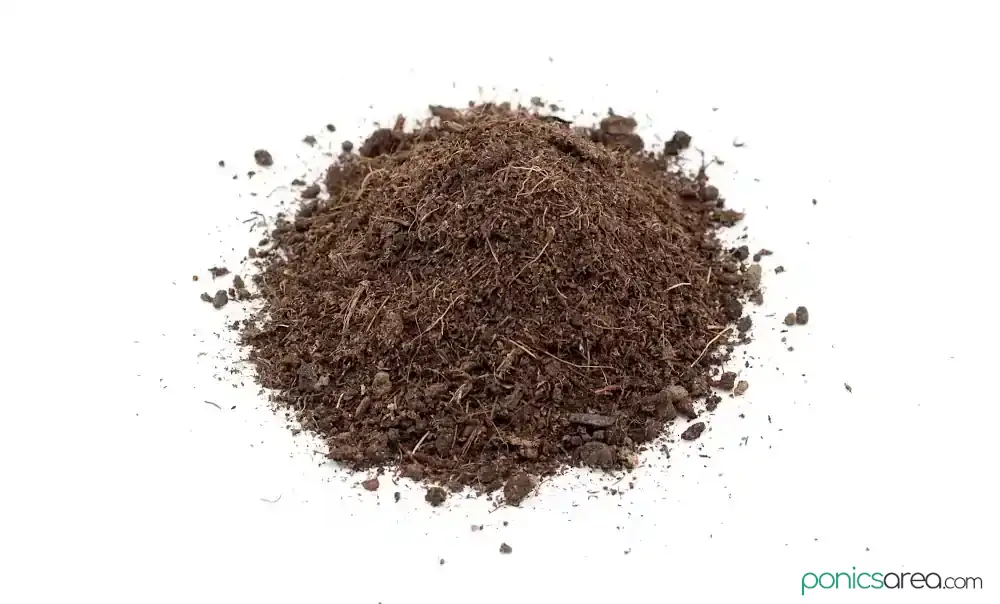
Coconut fiber
This one is quickly gaining popularity among hydroponic gardeners. It’s easy to see why: coco coir is pretty awesome.
If you can’t find coco coir, the perfect substitute is peat moss. They’re very similar in their benefits.
Coconut fiber has some awesome benefits as a best hydroponic growing medium:
- made of the outer husk of a coconut
- at the moment, it’s one of the most effective growing media and it’s also my second recommendation as the best hydroponic growing medium
- organic – more environmentally-friendly than peat moss
- coco coir has a very slow decomposition rate, it won’t affect the overall composition of the nutrient solution
- has a neutral pH
- retains moisture well, it can retain up to 20 times its weight in water
- stores nutrients well
- it holds moisture for a long time
- coco coir even provides proper aeration to the roots
- it’s pretty much great overall
- coco chips are another form that can be used for growing vegetables and herbs hydroponically
- coco chips have one advantage over coconut fiber: larger air pockets
- they’re also bigger so, coco chips can be placed in starter baskets without the risk of slipping through
3. Expanded clay aggregate (hydroton)

Expanded clay aggregate
This is another quite popular best hydroponic growing medium.
Expanded clay aggregate has the following properties:
- offers proper oxygenation, which is a big plus
- low water storage properties but that doesn’t have a negative impact in systems where the roots are in 24/7 contact with water and nutrient solution (a DWC with a raft is such a system)
- high drainability – hydroton can dry out pretty quickly so this is not a favorite for ebb and flow
- can get pretty heavy and that’s why hydroton is a first choice for DWC systems where the roots are in direct contact with water constantly so there’s no risk of drying out and the expanded clay aggregate can keep them from floating
- can be rinsed and reused, which is a big advantage if you want to save a bit on the costs
- before use, rinse them until there’s no more red liquid flowing out
- search for pH neutral varieties
4. Perlite
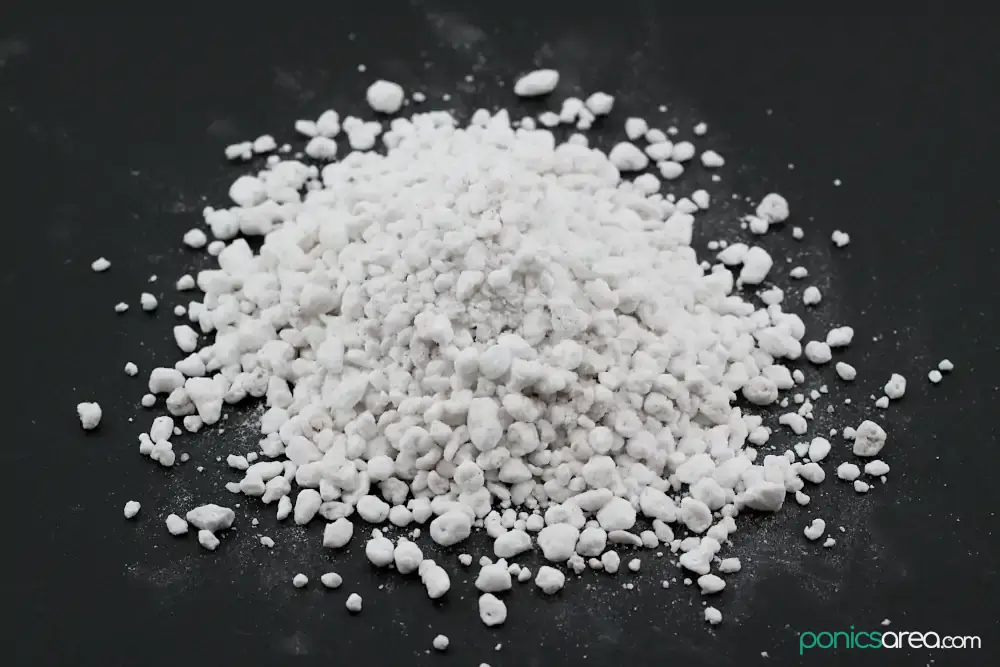
Perlite
This one is usually combined with other growth media in order to make them work better.
It can be combined with sand and vermiculite. Also, functions as an extra layer for expanded clay.
It is is characterized by:
- it’s a form of volcanic glass
- its appearance is that of tiny round white dots
- under heat, it is expanded to 13 times its previous size, popping like popcorn
- used to aerate media – that’s perlite’s main purpose in a hydroponics system
- very absorbent but since it’s also porous, the water and nutrients will also drain quickly
- perlite is a great choice for enveloping the roots in moisture and nutrients, while also ensuring that they have the needed oxygen because perlite is known for it aeration properties
- it also possesses thermal insulation properties
- extremely light
- because it’s so light, it can float in a hydroponics garden, which doesn’t make it a great growing medium for herbs
- naturally sterile
- great choice for hydroponic systems because it’s pH neutral
- a very good option for germinating seeds
5. Vermiculite
Vermiculite is a silicate mineral that’s also expanded under high heat, another pure natural material that has no negative environmental impact.
I decide to shortly characterize vermiculite immediately after perlite because they’re similar.
It’s also light so it can float in a hydroponics system but it’s great for the fact that it holds nutrients for future use.
Vermiculite absorbs large amounts of water.
It’s not to be used in an ebb and flow system because it’s too light.
But it works really well for germination.
Vermiculite can also be used in the making of compost for improving the overall composition.
6. Peat moss
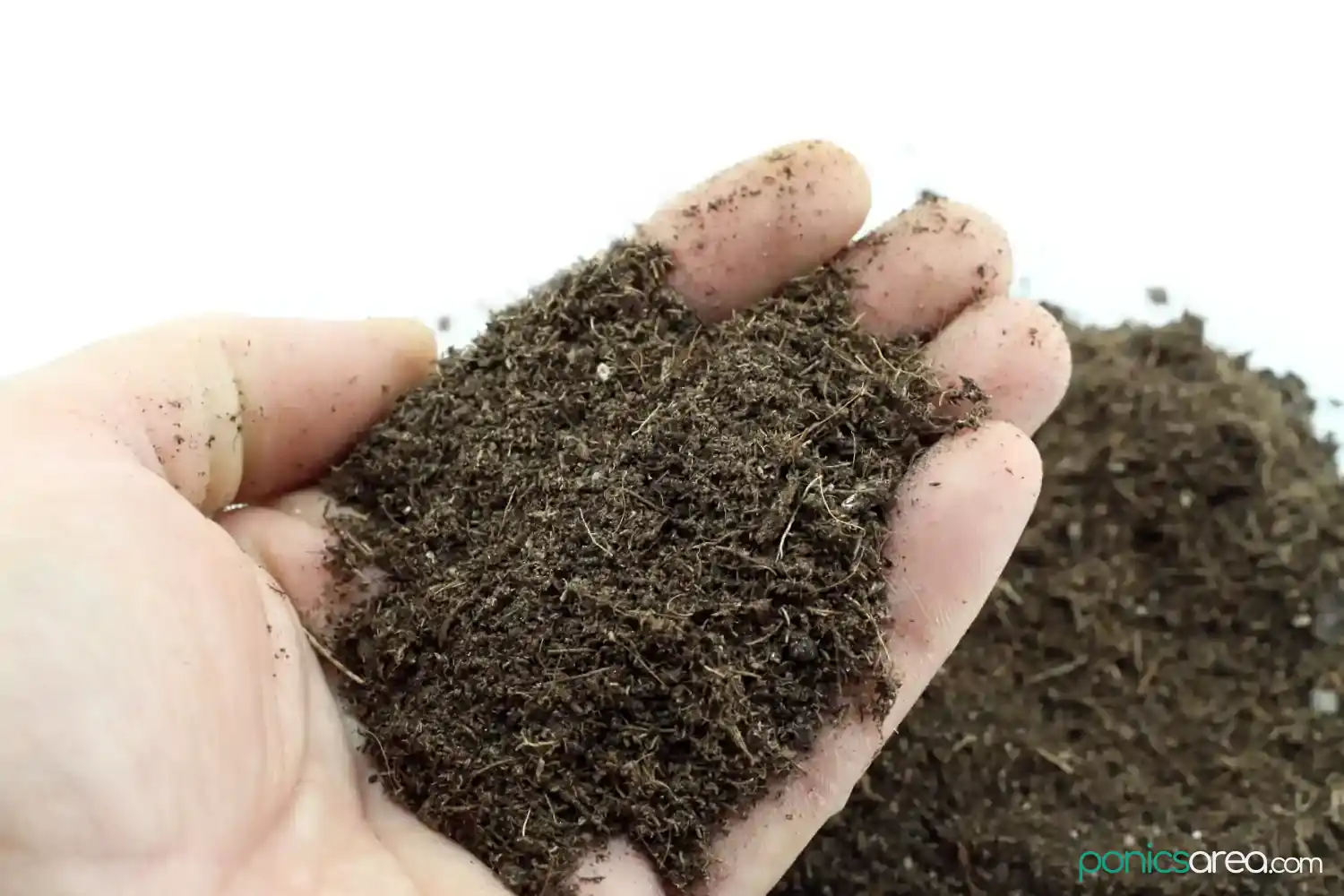
Peat Moss
- is almost as good as coco coir, peat moss is a great replacement for coconut fiber
- has high water storage capacity
- coconut and peat moss can be combined for growing seeds
- compostable
- impurities cannot be avoided
7. Pea gravel
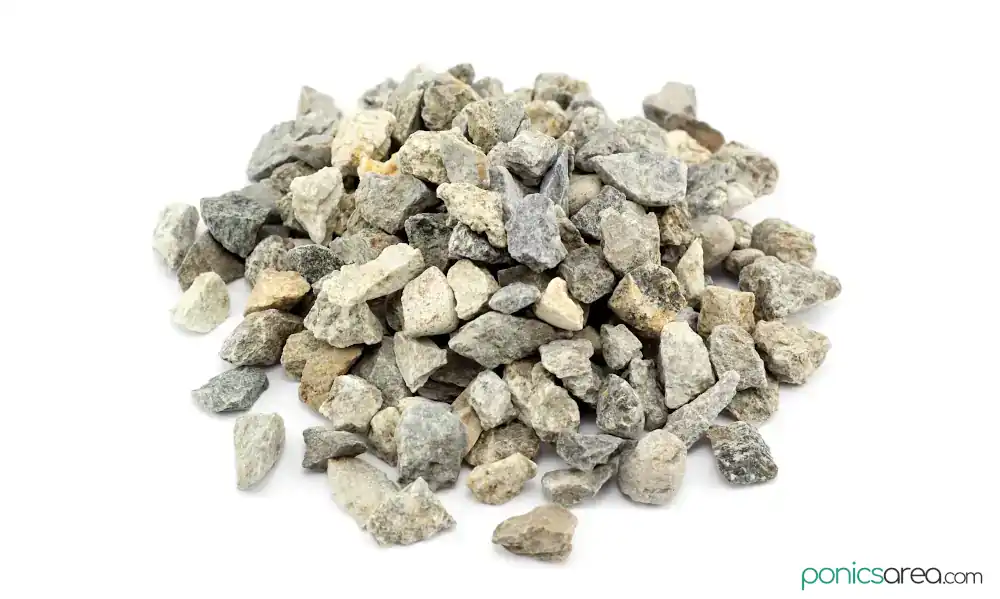
Pea Gravel
- this is coarse-grained sand
- can be used in ebb and flow systems
- has the advantage of being cheap or free
- the problem is that the roots can get too little water because pea gravel is not a best hydroponic growing medium that stores water well – that’s not a problem if it’s used in DWC systems
- can be reused after being sterilized
- it’s heavy
- the pH value is depended on the mineral content
8. Rice husks
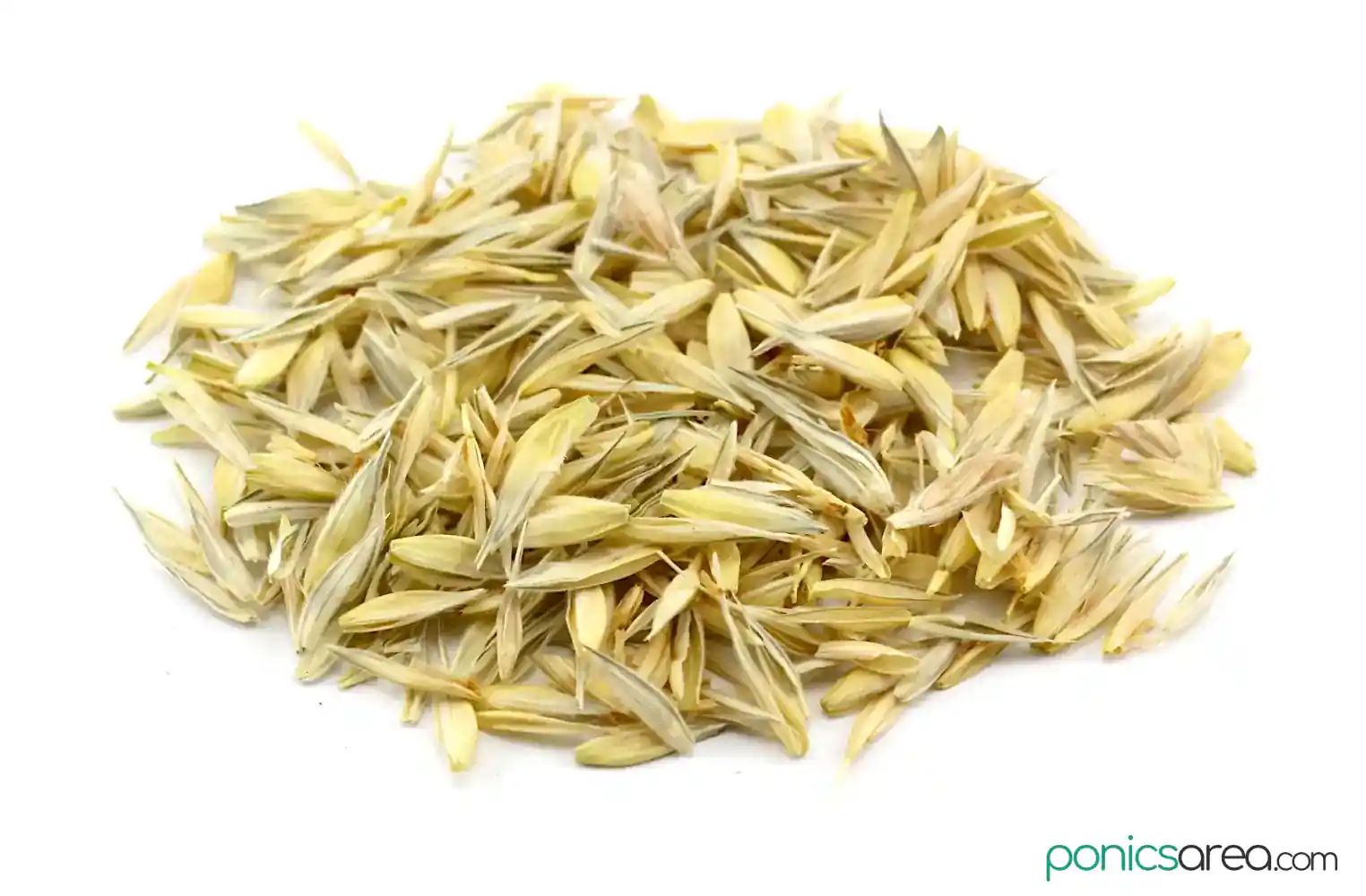
Image of rice husks
- rice husks are the coatings of grains of rice, waste from the rice industry
- sterile
organic and sustainable, great for the environment – can be turned into compost after use because rice husks cannot be reused - must be renewed regularly
- pH between 5.5 and 6.5 – great for hydroponics
- have the ability to increase porosity in the growth medium
- decomposes slowly, it won’t affect the nutrient solution’s composition
- good drainage
- higher ability to retain water than perlite – that makes rice husks the perfect perlite substitute
9. Sand
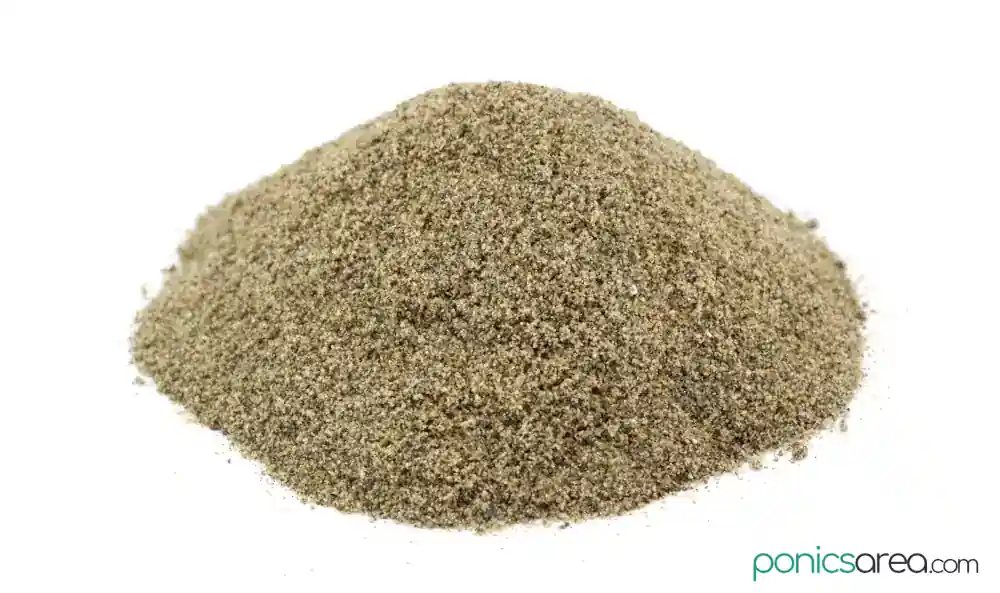
Image of sand
Let’s talk about one of the oldest best hydroponic growing media:
- it does a good job at retaining moisture
- works well in combination with perlite, vermiculite, and coco coir – using 20-30% sand in combination with perlite/vermiculite can prevent the result from being too heavy
- it’s best to use bigger grains in order to ensure proper aeration
- before using, rinse the sand with water to remove dust particles
- as I’m sure you’ve already figured it out, the major problem is the heavy weight
- the heavy weight will make it difficult to move the sand around once it’s set up in the system
10. Wood chips
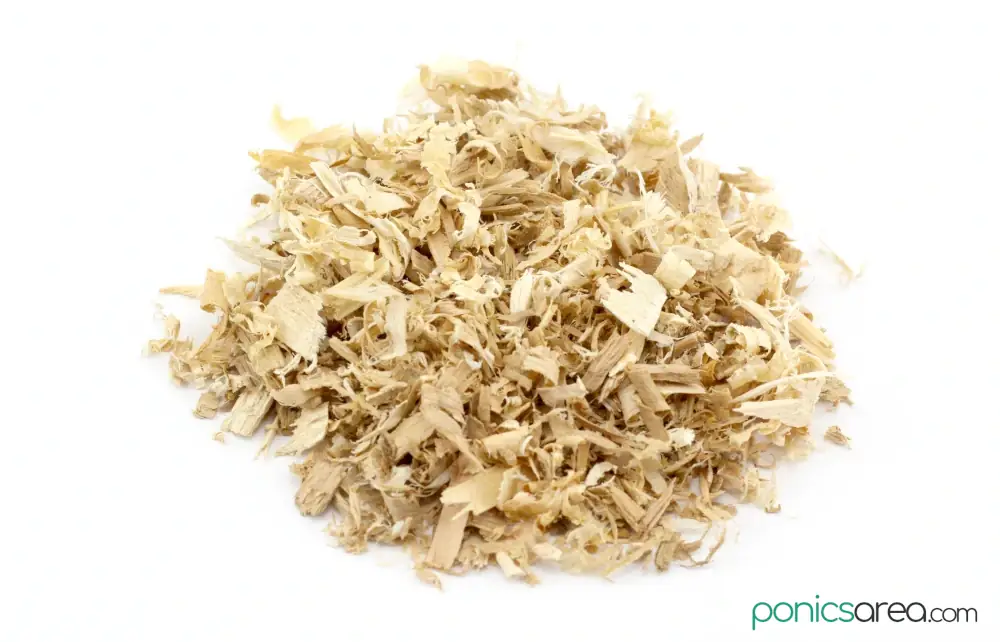
Image of wood chips
First of all, wood chips and sawdust are two very different things. Sawdust doesn’t work because first it’s too fine and then it become too firm from the water.
If we’re talking about a best hydroponic growing medium, then we’re talking about wood shavings, wood chips.
The idea is to go for coarser wood chips because those are the ones that will provide better ventilation for the roots. It’s one of reasons why wood shavings are also used when making compost, they provide air pockets.
However, keeping wood shaving permanently in the water will make them rot. They can work in an ebb and flow system if it has good drainage.
Also, get organic ones, free of chemical additives.
While wood chips can be considered a cheap grow medium for hydroponics, it has its cons: can cause pests and it rots with time.
11. Growstones
This is another substrate for growing plants with hydroponics and aquaponics. I mentioned it when I talked about ebb and flow hydroponic systems and it’s also very popular for aquaponics.
Growstones are a good option when we need to create very big grow beds for hydroponics or aquaponics.
We can use growstones/lava rocks/pea gravel spread out throughout the grow bed and rockwool or coconut fiber for the roots.
Thus, we generally don’t use growstones on their own. We use it to fill in a big grow bed and we use rockwool or coconut fiber for the roots. Although I think that lava rocks or pea gravel might be more popular among amateur growers.
Growstones are the bigger version of perlite.
They’re made from recycled glass bottles, which means that they’re a nice option for people who are looking for eco-friendly best hydroponic growing medium.
The downside of growstones is that they have bubbles, which lava rocks don’t.
The bubbles are hard to clean so using the same growstones for multiple growing seasons is not going to be a possibility.
Moreover, many plats will grow roots through the holes. That’s another reason for why we cannot reuse growstones. Why it definitely deserves a mention if we’re looking for the best hydroponic medium, I wouldn’t say that growstones are my go-to replacement for soil cultures.
Finding the Best Hydroponic Growing Medium Is Essential
Almost all hydroponics systems absolutely can’t grow plants without the use of a best hydroponic growing medium.
To offer you a short recap on hydroponics systems, the most important ones are: deep water culture, wicks, nutrient film technique, ebb and flow, drips, and aeroponics.
I said that almost all systems require a hydroponic growing medium. Let’s see which are the exceptions.
Well,
The last one, aeroponics is the exception to this rule that you absolutely need a best hydroponic growing medium in order to grow plants.
In aeroponics the roots of the plants are suspended and are sprayed once every few seconds with nutrients and water. Actually, air is the growing medium in aeroponics. That’s why this is the exception.
Furthermore,
There’s a choice to be made for nutrient film technique (NFT) systems. Some users choose to not use a growing medium with NFT because the plants grown with a NFT only have the ends of their roots touching the water. In this case, the plants are never drowned in water and nutrients. The side-effect of this is that users can’t grow plants with a large root system. You can still go for leafy greens and even strawberries.
Others choose to use a medium even with a NFT, one that doesn’t retain much water but one that supports the plants really well.
A deep water culture doesn’t necessarily require a growing medium. The roots can be left to float freely in the reservoir, just being supported by a floating raft. Even so, those who choose to use one, prefer expanded clay aggregate as a best hydroponic growing medium for DWC.
The Role of Grow Media for Hydroponics
The role of grow media for hydroponics is that they replace the role of the soil.
When you’re looking for the best hydroponic growing medium, you’re looking for the material that will support the plants while growing up. The grow media is also the one that absorbs the water and the nutrients and delivers it to the roots of the plants. It also delivers oxygen.
In hydroponics systems it never goes dry.
The people who want to build their own hydroponics systems, need to find the best hydroponic growing medium for their system and I hope that I’ve made things easier with my article on grow media.
Hydroponics Growing Medium FAQs
This article about the best hydroponic growing medium might be quite long for some. Here are the most frequently asked questions about growth media for hydroponics. Read the answers and you’ll get all the needed facts in just a couple of minutes.
Q. Do hydroponic plants need soil?
In a hydroponics system, the role of the soil is replaced by a growing medium. Water, nutrient-rich solution, and grow media are all you need for growing plants hydroponically. 4 of the most popular grow media are rockwool, coconut fiber (coco coir), expanded clay aggregate, and perlite. There are many more others like rice husks, peat moss, pea gravel, wood chips, sand, lava rocks etc.
Q. Do you need a medium for hydroponics?
The role of a growth medium in hydroponics is to support the plants as they’re growing up and to deliver water and nutrients to the roots. It’s an essential role. If you’re using a DWC or a NFT, you can skip using a medium, there are growers who do and others who don’t even with these two systems. Another exception is made by aeroponics, where the growing medium is the air because the roots are suspended in the air and are sprayed with a fine mist consisting of water & nutrients.
Q. What can I use instead of rockwool for hydroponics?
For germinating seeds, oasis cubes are the best replacement for rockwool. As full blown growing media, the best alternatives to rockwool are coco coir, expanded clay aggregate, rice husks, pea gravel, sand.
Q. What growing medium is best for hydroponics?
There is no universal best hydroponic growing medium, a big factor in the choice you make is influenced by the system you’re using: for DWC you can use expanded clay aggregate or even pea gravel, with wicks you can use coconut fiber/vermiculite/perlite, in a NFT you can opt for rockwool/expanded clay aggregate/coconut fiber or none at all, a combination of growstones/pea gravel and rockwool/coconut fiber works for ebb and flow, and for drips you can use peat moss or coconut coir.

